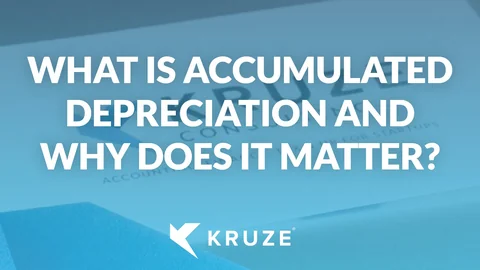
What is Accumulated Depreciation?
Accumulated depreciation is the total amount of an asset’s value that has decreased over time due to depreciation. It’s recorded on a company’s balance sheet and is a somewhat important factor in financial reporting and asset valuation.
Accumulated depreciation is called a “contra asset” because it reduces the asset’s overall value. It shows how much wear and tear or usage the asset has experienced since it was first purchased.
As time goes by, the amount of accumulated depreciation grows as the company records more depreciation expenses. When the asset is eventually sold or no longer used, this accumulated depreciation is reversed, and the asset is removed from the balance sheet.
Companies spread out the cost of an asset’s loss in value over its useful life. Some common assets that accumulate depreciation include vehicles, furniture, computers, and equipment. On the balance sheet, you can usually find the accumulated depreciation listed just below the asset it relates to.
Accumulated Depreciation and Your Startup’s Chart of Accounts (COA)
Accumulated depreciation is a key part of a startup’s chart of accounts (COA) because it tracks how much an asset’s value has decreased over time. It’s listed as a contra asset account, which means it reduces the total value of the related fixed asset on the balance sheet.
Here’s how it works:
- Fixed Assets: When a company buys something like equipment, the full cost is recorded in a fixed asset account in the COA.
- Accumulated Depreciation: As the asset depreciates, the accumulated depreciation account records how much of its value has been used up, lowering the asset’s value over time.
Including accumulated depreciation in the COA helps companies keep track of both the original cost of an asset and how much value it has lost, making financial reporting and tax calculations more accurate.
Example of Accumulated Depreciation
If a startup buys computers for $10,000 and expects them to last five years, they would record $2,000 in depreciation (dividing the total cost by five years) each year.
After the first year, the accumulated depreciation would be $2,000. After two years, it would be $4,000. This amount continues to increase each year.
By the end of the fifth year, the accumulated depreciation would equal the original $10,000 cost, meaning the computers are fully depreciated. When the computers are sold or no longer used, the accumulated depreciation is removed from the balance sheet.
This method helps the startup spread out the cost of big purchases over time, giving a clearer view of its finances.
How Does Accumulated Depreciation Work?
When a business buys an asset, it loses value over time, and this loss is recorded as accumulated depreciation. This helps track how much value the asset has lost since it was purchased and gives a clearer picture of its current worth on the balance sheet.
Here’s a breakdown of how accumulated depreciation works:
- How It’s Calculated: To figure out yearly depreciation, subtract the asset’s salvage value (the amount it could be sold for at the end of its life) from the purchase price, then divide that by the number of years the asset is expected to last.
- On the Balance Sheet: Accumulated depreciation appears as a credit on the balance sheet, reducing the overall value of the asset and showing its current book value.
- Over Time: Depreciation builds up year after year. Businesses can use methods that record more depreciation in the early years of an asset’s life to speed this up.
- When the Asset Is Sold or Retired: Once an asset is sold or no longer in use, the accumulated depreciation is reversed, and the asset is removed from the balance sheet.
Common assets that use accumulated depreciation include:
- Vehicles
- Factory machinery
- Computers
- Buildings
- Office equipment
- Furniture
How is Accumulated Depreciation Calculated?
There are several ways to calculate accumulated depreciation, each designed to fit different types of assets and how they’re used. For small business owners and solopreneurs, understanding these methods is important for making informed decisions about buying and managing assets like office equipment or furniture.
Here are the four main depreciation methods allowed by generally accepted accounting principles (GAAP):
- Straight-Line Method: Spreads the depreciation evenly over the asset’s useful life.
- Declining Balance Method: Depreciation is higher in the early years and decreases over time.
- Sum-of-the-Years’ Digits (SYD): An accelerated method that applies more depreciation in the earlier years of the asset’s life.
- Units of Production Method: Depreciation is based on how much the asset is actually used, making it ideal for equipment or machinery.
Let’s take a look at each method below.
Straight Line
The straight-line method calculates depreciation by deducting the same amount each year over an asset’s useful life.
To figure out the annual depreciation, subtract the asset’s estimated salvage value (how much it might be worth at the end of its life) from its original cost. Then, divide that amount by the number of years you expect to use the asset.
For example, a startup buys office furniture for $10,000 and expects it to last 5 years, with no resale value at the end. Using the straight-line method, the startup will depreciate the furniture by dividing the $10,000 cost over 5 years, which equals $2,000 per year.
This means the startup will record $2,000 in depreciation each year, making it easy to spread the cost of the furniture evenly over its useful life.
If you don’t use the asset for a full year in the first year, you’ll need to adjust the depreciation for the months of use. The straight-line method provides an easy way to evenly spread out the loss in value over the asset’s useful life.
Declining Balance
The declining balance method allows businesses to deduct more of an asset’s value in the early years of its life. The declining balance method calculates depreciation as a percentage of the asset’s current value. Since the asset’s value decreases each year, the amount of depreciation also decreases over time.
For example, if a startup buys equipment for $10,000 and uses a 20% depreciation rate, the first year’s depreciation would be $2,000 (20% of $10,000). In the second year, the book value drops to $8,000, and the depreciation is $1,600 (20% of $8,000), and it continues to decrease each year.
This method is helpful for assets that lose value quickly, like technology or machinery, as it lets businesses account for most of the depreciation during the early years when the asset is most useful.
A subset of the declining balance method is the double-declining balance method, which is an even faster way to depreciate an asset, with higher depreciation in the early years and lower amounts later.
For example, if a startup buys equipment for $50,000 with a 10-year lifespan and no resale value, the straight-line rate would be 10%. Doubling this rate, the company would depreciate the equipment at 20% per year. In the first year, they would record $10,000 in depreciation (20% of $50,000). In the second year, the depreciation would be $8,000 (20% of the remaining $40,000), and so on.
This method is ideal for assets that lose value quickly, like technology or machinery.
Sum-of-the-Year’s Digits
The sum-of-the-years’ digits (SYD) method is another accelerated way to calculate depreciation, focusing on higher depreciation in the early years of an asset’s life and less in the later years. This method is often used for assets that lose value quickly, like vehicles or electronics.
To use the SYD method, you add up the digits of the asset’s expected lifespan. For example, if the asset lasts five years, you add 5 + 4 + 3 + 2 + 1, which equals 15. Each year, a percentage of the asset’s value is depreciated, starting with the highest in the first year.
For example, if a company buys equipment for $15,000 with a five-year life, they would depreciate 33.3% ($5,000) in the first year, 26.7% ($4,000) in the second year, and smaller amounts each following year. This method allows businesses to account for more depreciation early on when the asset loses value faster.
Units of Production
The Units of Production Method ties depreciation to how much an asset is used, making it ideal for equipment or vehicles with varying usage each year. Instead of spreading depreciation evenly, this method calculates it based on how many units or services the asset produces.
For example, a company buys a machine for $60,000 and expects it to produce 300,000 units over its life. In the first year, the machine produces 50,000 units. To calculate depreciation, the company figures out the depreciation per unit:
$60,000 ÷ 300,000 units = $0.20 per unit.
Since the machine produced 50,000 units in the first year, the depreciation is:
50,000 units × $0.20 = $10,000.
If the machine produces more or fewer units in the following years, the depreciation adjusts based on actual usage, making this method great for assets that experience wear and tear based on how much they are used.
This method is useful for assets like vehicles or machinery, where wear and tear depend on actual usage rather than time, ensuring that depreciation reflects how much the asset is used each year.
Accumulated Depreciation vs. Depreciation?
Depreciation and accumulated depreciation are both important concepts for understanding the value of an asset over time, but they serve different purposes in accounting.
Depreciation is the amount of an asset’s value that is used up during a specific time period. It shows how much of the asset’s cost has been used and is recorded as an expense on the income statement.
Accumulated depreciation is the total amount of depreciation recorded since the asset was purchased. It’s shown on the balance sheet as a negative value that reduces the asset’s overall worth.
The main difference is that depreciation shows the loss in value for a single period, while accumulated depreciation shows the total loss over the asset’s entire life. Both are important for tracking the asset’s true value for accounting and tax purposes.
Accumulated Depreciation vs. Accelerated Depreciation?
Accumulated depreciation and accelerated depreciation are different but important concepts in accounting.
Accumulated depreciation is the total depreciation recorded on an asset over its life, reducing its value on the balance sheet.
Accelerated depreciation is a method that allows for higher depreciation in the early years of an asset’s life, with smaller amounts later on. This method reflects the idea that assets are used more when they are new, and is often used to reduce taxes early in the asset’s life.
In short, accumulated depreciation shows the total depreciation over time, while accelerated depreciation is a way to speed up depreciation in the early years.
Why Startups Need to Track Accumulated Depreciation
For startups, tracking accumulated depreciation is important to get a clear and accurate view of your financial health. It helps show the true value of assets over time, which is key for business planning, tax compliance, and gaining investor trust.
Here’s how accumulated depreciation affects startups:
- Balance sheet: Reduces the value of fixed assets, showing their actual worth.
- Income statement: Records depreciation as an expense, lowering net income.
- Taxes: Allows for tax deductions on depreciated assets, reducing tax liability.
- Asset valuation: Gives a more accurate picture of asset value, which is important for investors.
Tracking depreciation helps startups make better decisions about when to replace assets, how much to budget, and spreads the cost of assets over several years to avoid a big impact on profits in one year. It can also reduce taxes in the early stages of the business.
Take full advantage of tax benefits for your startup
If you need help with accumulated depreciation, startup tax planning, including general business credits, Form 1120, and whether you need to file a tax return at all, reach out to Kruze Consulting for help. We are experts at tax credits for startups.








